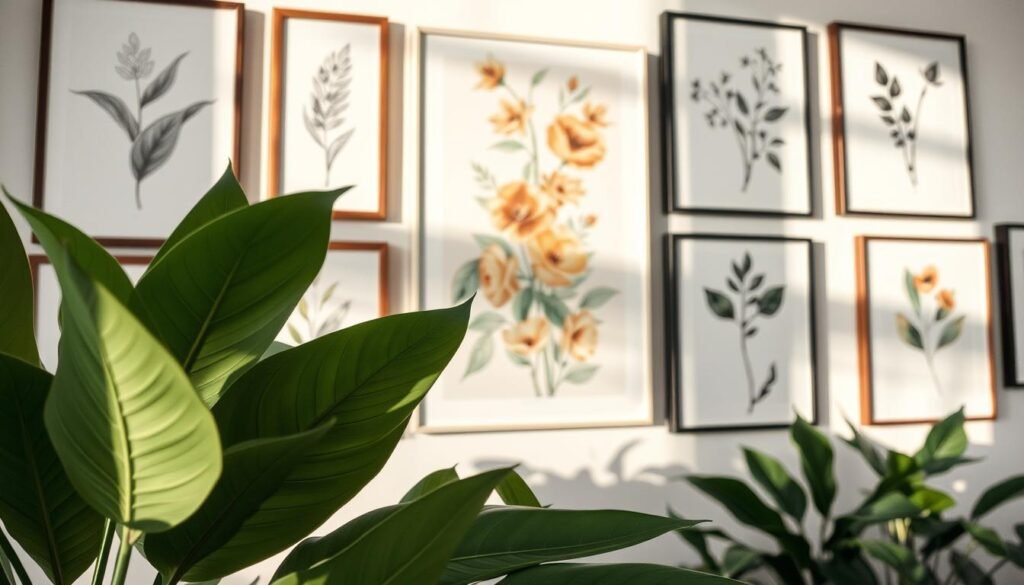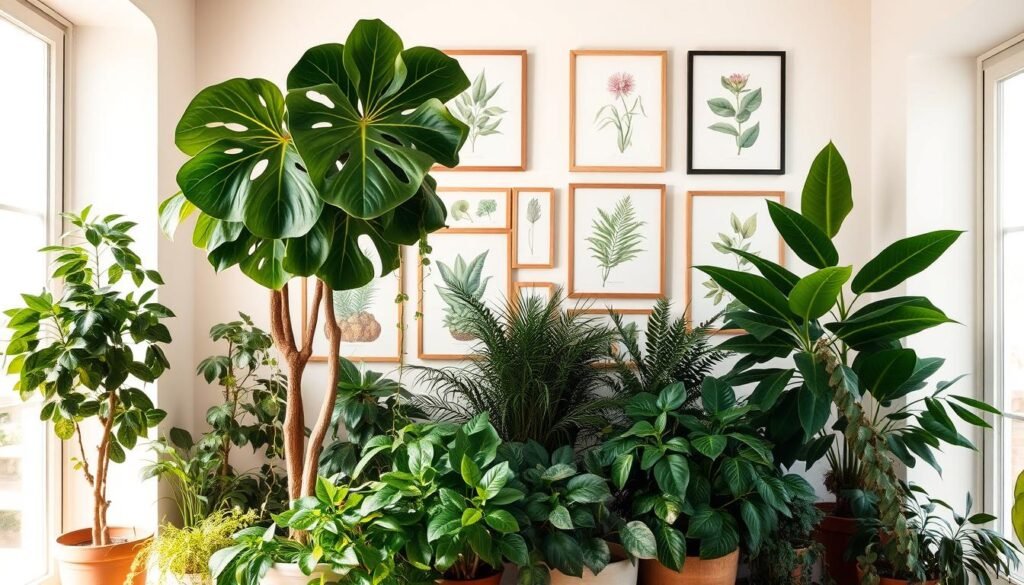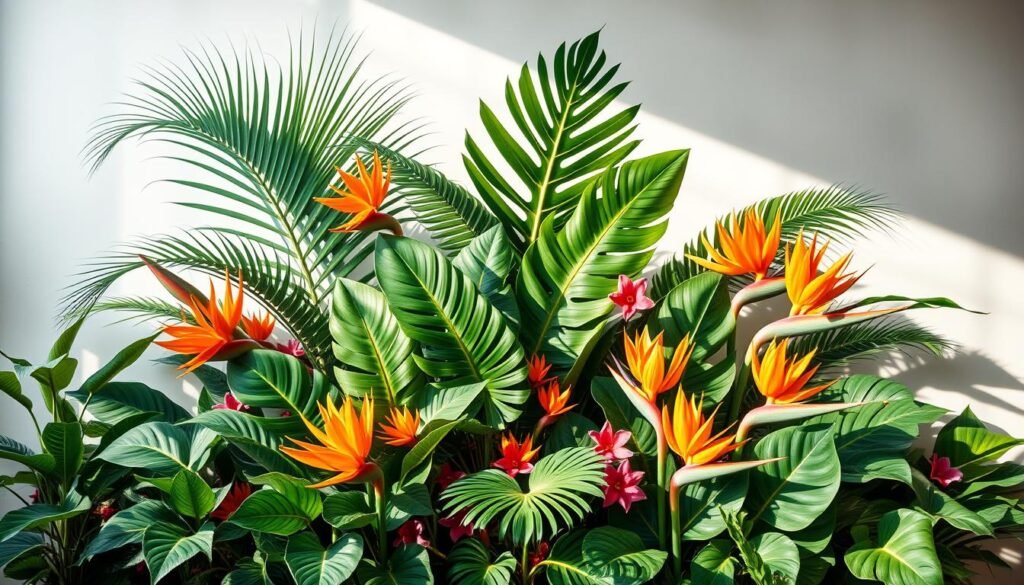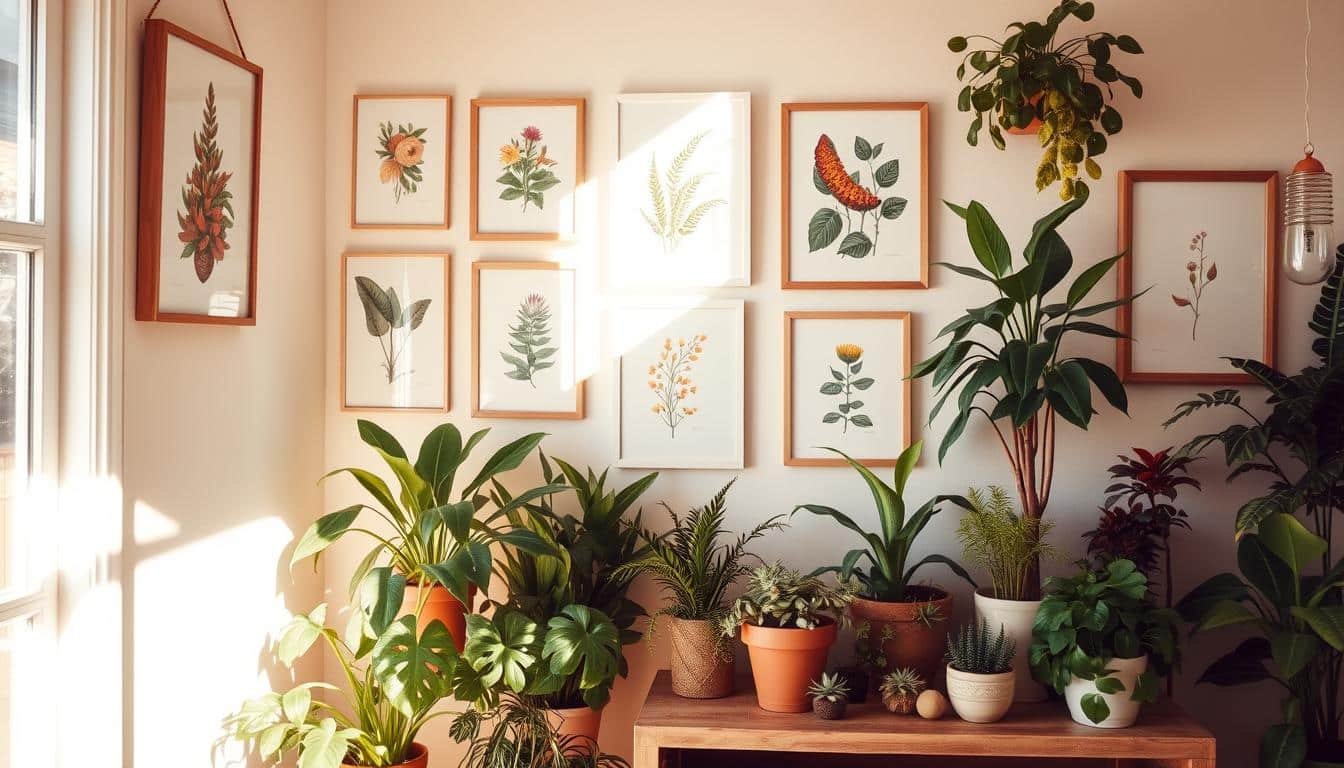This post may contain affiliate links. When you purchase through links on our site, we may earn an affiliate commission.
What if your home’s design is missing one simple element that brings both life and style into harmony? I asked myself this years ago while staring at my bland living area. Today, my space breathes with energy—not through costly renovations, but by blending living greenery and art that whispers “welcome to the jungle.”
When I first experimented with leafy companions and framed foliage art, I realized most guides overcomplicate things. My method? Pair resilient plants like snake varieties or pothos with bold, oversized prints of monstera leaves or palm fronds. This combo works in dim apartments and sunlit lofts alike—no green thumb required.
The magic happens when you treat plants as textural accents rather than décor afterthoughts. A fiddle-leaf fig beside a black-and-white fern print adds depth without clutter. I’ve found that contrasting organic shapes against geometric planters creates balance, turning any corner into a curated escape.
Key Takeaways
- Live greenery and nature-inspired art create instant visual harmony
- Choose low-maintenance plants that thrive in your light conditions
- Mix organic plant shapes with structured frames for contrast
- Use large-scale botanical artwork as focal points
- Refresh spaces without renovations through strategic placement
Introduction: A Fresh Take on Living Spaces
Have you ever walked into a room that felt like a breath of fresh air? That’s the power of blending organic elements with thoughtful interior design. I discovered this truth after years of trial and error—and science backs it up.
https://www.youtube.com/watch?v=DcdKkgn_yX8
The Influence of Nature on Home Ambience
Research shows leafy companions do more than look pretty. They filter toxins and boost oxygen levels. One NASA study found certain species remove up to 87% of air pollutants in 24 hours.
But it’s not just about cleaner air. My favorite discovery? Workers near greenery report 15% higher creativity. I’ve seen how a peace lily by my desk helps me tackle projects with clearer focus.
My Journey with Botanical Decor
It started with a spider plant from my grandma. Soon, I added framed vintage seed packets above it. The change was instant—my apartment went from generic to alive.
Here’s what works best:
| Element | Benefits | Maintenance Level |
|---|---|---|
| Live Plants | Air purification, humidity control | Low (e.g., ZZ plants) |
| Botanical Art | Visual interest, stress reduction | None |
This combo transformed my space into a sanctuary. Friends now ask, “How’d you make it feel so welcoming?” My secret? Letting nature lead the design.
Curating Your Perfect Gallery Wall Botanical Setup
A gallery wall isn’t just decor—it’s a living diary of your favorite green moments, frozen in art. My approach combines intentional storytelling with visual rhythm, turning blank walls into conversation-starting features.

Selecting Diverse Botanical Art
I hunt for pieces spanning centuries—18th-century herbarium sketches beside modern abstract florals. A botanical art collection should showcase ferns, succulents, and tropical blooms together. This variety mimics nature’s own diversity.
Vintage seed catalogs make charming additions. I recently framed a 1940s rose diagram—its faded hues complement my neon monstera print perfectly.
Mixing Frames and Finishes
Matte black metal frames anchor airy palm prints, while walnut wood borders warm up scientific illustrations. I’ll sometimes leave one piece unframed for raw texture.
My pro tip? Spray-paint mismatched thrift store frames the same cream tone. Instant cohesion without sacrificing character.
Creating a Personalized Display
I arrange gallery wall elements on the floor first. Start with the largest piece off-center, then radiate smaller works outward. Leave 2-3 inches between frames for breathing room.
Incorporate 3D elements—a pressed flower shadowbox or brass leaf sculpture adds depth. My current display features my grandmother’s gardening notes beside new botanical art purchases. Together, they whisper family history.
How I Enhance Rooms with Indoor Plants and Botanical Prints
Transforming a space into a natural retreat doesn’t require magic—just smart pairings. My strategy focuses on blending living greenery with artistic accents that echo nature’s patterns. The secret? Treating every corner as a chance to balance vitality and calm.

My Easy and Effective Tips
I begin by studying sunlight patterns and wall colors. A north-facing room might host a ZZ plant beneath a muted fern illustration, while sun-drenched areas could feature vibrant bird-of-paradise prints beside aloe vera. This light-based pairing ensures both thrive visually.
Layering textures creates depth without chaos. A trailing pothos spills from a high shelf above a framed palm frond sketch. On the floor, a chunky rattan planter holds a rubber tree—its glossy leaves mirroring nearby artwork’s curves. These combinations form visual conversations between living and static elements.
Functional spaces get tailored treatments:
- Bedrooms: Snake plants paired with soft watercolor florals
- Home offices: Air-purifying peace lilies near geometric leaf patterns
- Entryways: Bold monstera prints with easy-care succulents
I often use artwork to solve “dead zones” where greenery struggles. A striking agave photograph above a radiator becomes a focal point, while real plants flourish elsewhere. This approach lets every inch contribute to the room’s natural narrative.
Making a Bold Statement with Large Botanical Wall Art
Oversized botanical art does more than fill wall space—it becomes the room’s heartbeat. I discovered this when a five-foot palm frond print transformed my bland dining area into a tropical retreat. The right piece anchors your interior while sparking daily joy.

Choosing Artwork in Harmony with Furniture
I match botanical art to my sofa’s undertones. A charcoal fern print pops against gray upholstery, while golden pampas grass complements warm wood tones. Always measure your furniture first—art should span ⅔ its width for balance.
Arranging for a Cohesive Look
Centering a statement piece above a console table creates instant focus. I leave 6-8 inches between frames in gallery clusters. For single wall art, position the center at 57” from the floor—the average eye level.
Three rules I live by:
- Echo two colors from existing textiles or decor
- Mix organic shapes with structured frames
- Let sunlight guide placement (avoid direct glare)
Last month, I hung a magnolia print above my navy armchair. The blush tones in the petals matched my rug’s pattern, creating that cohesive look clients always ask about. When art and furniture sing the same visual melody, your space feels effortlessly intentional.
Inspiring Picture Shelf Ideas for Dynamic Displays
Picture shelves became my secret weapon for crafting spaces that evolve with my mood. Unlike static gallery walls, these floating ledges let me rearrange prints like puzzle pieces. I once transformed my living room from tropical oasis to desert retreat in 20 minutes—just by swapping palm prints for agave photographs.
Rotating Favorite Prints
I keep a stash of 15-20 framed pieces in my closet. Every season, I curate new combinations—vintage fern sketches might mingle with abstract leaf patterns. Last week, I paired a 1920s rose diagram with my nephew’s cactus watercolor. The result? A gallery that feels both timeless and personal.
Incorporating Greenery and Textures
Trailing pothos vines soften shelf edges, while chunky rattan baskets hold spare frames. I balance delicate air plants with rough-hewn wood carvings. Pro tip: Use stacked art books as risers to create elevation changes. This trick adds depth without crowding the design.
My current favorite arrangement layers:
- A framed monstera print leaning against the wall
- Mini succulents in terracotta pots
- Woven textile art from Mexico
The key lies in mixing natural materials with intentional negative space. Let each element breathe while maintaining visual flow. When done right, your shelf becomes a living gallery that grows alongside your plants.
Embracing the Charm of Botanical Posters and Minimalist Prints
The right wall art can whisper or shout—my botanical posters do both. These accessible pieces let me refresh spaces like a mood ring, shifting energy from tranquil to vibrant with paper and ink. Unlike permanent fixtures, they’re playful collaborators in my design experiments.
Balancing Bold and Subtle Designs
I treat bold botanical prints like exclamation points. A fiery poppy poster becomes my living room’s focal point, balanced by matte black frames and neutral throw pillows. In bedrooms, muted fern sketches on cream paper add texture without demanding attention.
My studio apartment taught me minimalist magic. Tiny walls thrive with small-scale prints—think single eucalyptus stems or geometric succulents. These subtle touches soften white walls better than bulky art, creating breathing room in tight spaces.
For cohesive style, I match poster tones to existing elements. My sage green sofa inspired a collection of vintage herb charts with similar hues. When I crave contrast, black-and-white palm frond prints pop against yellow accent walls.
Three rules guide my mixes:
- Pair detailed botanicals with solid-color frames
- Use large posters as anchors for gallery clusters
- Rotate seasonal pieces to prevent visual fatigue
Last month, I layered a delicate mushroom print over textured linen wallpaper. The combo transformed my entryway into a woodland vignette—proof that paper and plants share the same interior language.
Designing Accent Walls with Botanical Wallpaper
Your walls are blank canvases waiting to tell a story—mine now whisper tales of tropical jungles and desert blooms. One bold accent wall can redefine your entire space, blending art and nature into a single breath-taking feature. I use removable wallpaper for this magic trick—no commitment required.
Installing Bold Patterns
Go big or go home. Oversized palm fronds or tangled vines create instant drama. I pair these patterns with minimalist furniture to avoid visual overload. Pro tip: Match one color from the wallpaper to existing throw pillows for cohesion.
Customizing for Your Space
Why stop at walls? I’ve lined bookshelves with subtle leaf motifs—a surprise pop when shelves empty. In small rooms, vertical stripes of fern designs lift ceilings visually. Last month, I wrapped a closet’s interior with cherry blossom paper. Opening it feels like spring morning.
Remember: Your space should grow with you. That peel-and-stick monstera wallpaper? It’s survived three moves. When your design tastes evolve, your accent wall can too—no scrapping required.

 using WordPress and
using WordPress and 
No responses yet